Ethereum vs Ethereum Killers: Is ETH at Risk?
In this article, the author reflects on the concept of "Ethereum killers" and how the blockchain ecosystem has evolved since 2021. They argue that the debate between Ethereum and its competitors has become more complex and nuanced, and that surface-level comparisons based solely on facts and figures are no longer sufficient.
The author first highlights the key differentiating factor between Ethereum and its competitors, which lies in Ethereum's simplicity and its focus on providing a minimal yet robust framework for diverse applications. They point out that Ethereum's architecture, with its Turing-complete programming language Solidity, has allowed for the flourishing of the decentralized finance (DeFi) ecosystem.
However, as the blockchain landscape has matured, users are seeking out platforms that align more closely with their specific needs. This has given rise to specialized blockchain networks that prioritize scalability, interoperability, on-chain privacy, and modularity. The author provides examples of popular layer-1 networks like Solana, Sui, Near Protocol, Avalanche, Cosmos Network, and Polkadot, highlighting their unique features and trade-offs.
The author argues that Ethereum's simplicity and first-mover advantage have allowed it to serve as a versatile foundation for many applications. While other blockchains may attract migration from Ethereum due to their specialized features, the blockchain ecosystem is diverse enough to support multiple networks, each fulfilling specific needs and contributing to the overall Web3 landscape.
Furthermore, the author discusses the concept of modularity in Ethereum, whereby the blockchain can be abstracted into different layers, each serving a specific function. They explore different rollup configurations and highlight that comparing blockchains as standalone networks is becoming impractical as the ecosystem evolves to prioritize application-specific configurations and collaborative frameworks.
In conclusion, the author emphasizes that Ethereum and its competitors coexist within an interconnected Web3 ecosystem. They argue that the narrative of Ethereum killers needs to be reevaluated, as these specialized networks are not necessarily in direct competition with Ethereum but rather contribute to the overall diversity of the blockchain landscape. The concept of modularity in Ethereum allows for scalability, efficiency, and collaboration with other networks, redefining Ethereum's role in the blockchain ecosystem.
In this article, the author reflects on the concept of "Ethereum killers" and how the blockchain ecosystem has evolved since 2021. They argue that the debate between Ethereum and its competitors has become more complex and nuanced, and that surface-level comparisons based solely on facts and figures are no longer sufficient.
The author first highlights the key differentiating factor between Ethereum and its competitors, which lies in Ethereum's simplicity and its focus on providing a minimal yet robust framework for diverse applications. They point out that Ethereum's architecture, with its Turing-complete programming language Solidity, has allowed for the flourishing of the decentralized finance (DeFi) ecosystem.
However, as the blockchain landscape has matured, users are seeking out platforms that align more closely with their specific needs. This has given rise to specialized blockchain networks that prioritize scalability, interoperability, on-chain privacy, and modularity. The author provides examples of popular layer-1 networks like Solana, Sui, Near Protocol, Avalanche, Cosmos Network, and Polkadot, highlighting their unique features and trade-offs.
The author argues that Ethereum's simplicity and first-mover advantage have allowed it to serve as a versatile foundation for many applications. While other blockchains may attract migration from Ethereum due to their specialized features, the blockchain ecosystem is diverse enough to support multiple networks, each fulfilling specific needs and contributing to the overall Web3 landscape.
Furthermore, the author discusses the concept of modularity in Ethereum, whereby the blockchain can be abstracted into different layers, each serving a specific function. They explore different rollup configurations and highlight that comparing blockchains as standalone networks is becoming impractical as the ecosystem evolves to prioritize application-specific configurations and collaborative frameworks.
In conclusion, the author emphasizes that Ethereum and its competitors coexist within an interconnected Web3 ecosystem. They argue that the narrative of Ethereum killers needs to be reevaluated, as these specialized networks are not necessarily in direct competition with Ethereum but rather contribute to the overall diversity of the blockchain landscape. The concept of modularity in Ethereum allows for scalability, efficiency, and collaboration with other networks, redefining Ethereum's role in the blockchain ecosystem.
My first interaction with blockchain technology was in early 2021. Solana was just entering the scene at the time, creating quite a stir with its astonishingly fast throughput. During this exploration, I first stumbled upon the term "Ethereum killer," a label that sparked curiosity and skepticism alike.
That time marked the height of the last bull run, which debuted several layer-1 and layer-2 blockchain networks. Back then, blockchain applications and the user base were relatively narrow in scope, and the competition to attract the most users was palpable.
In crypto communities and forums, the debate on Ethereum versus its so-called "killers" was rampant, with enthusiasts zealously comparing every conceivable metric to crown the ultimate champion.
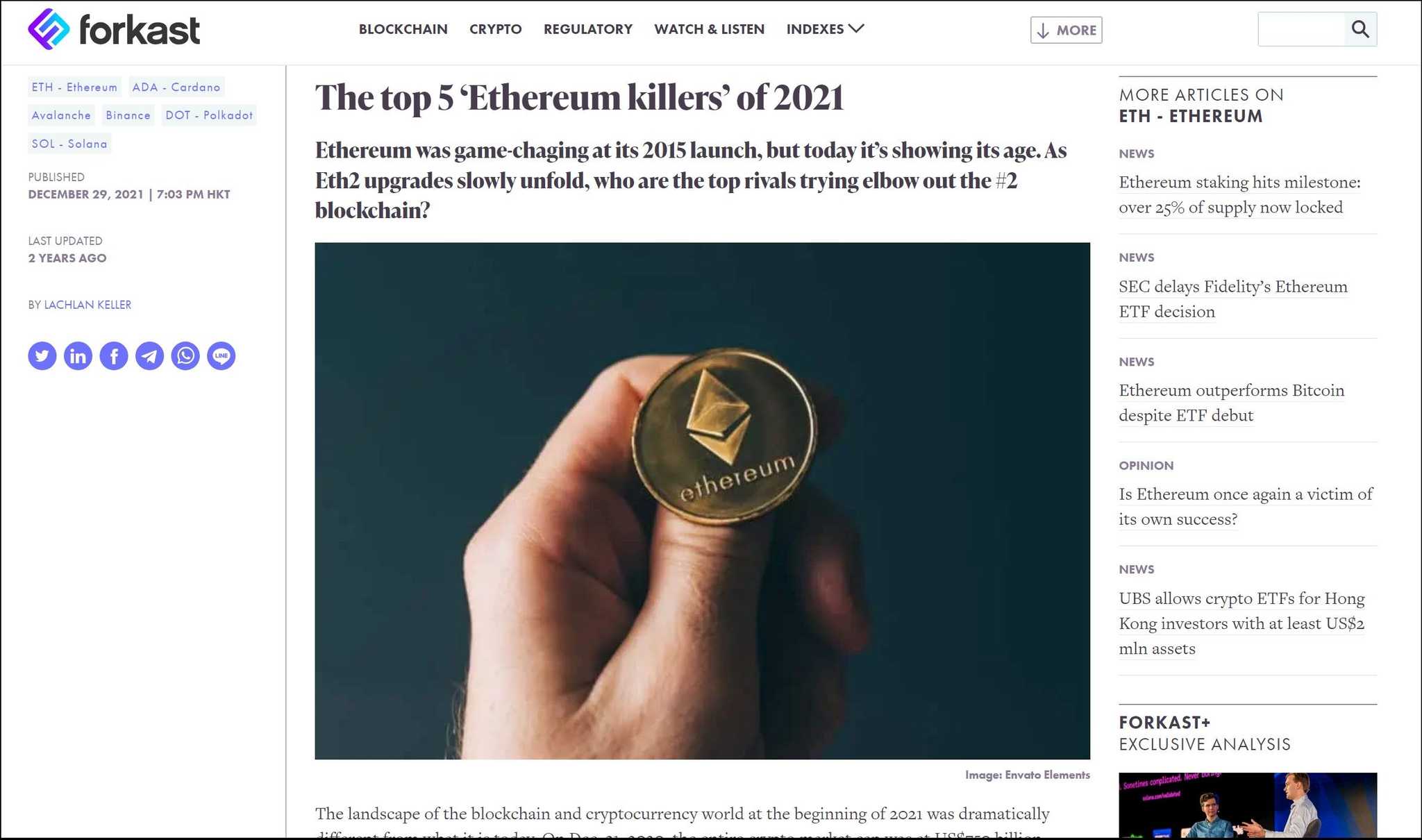
So, when the Coin Bureau team decided to tackle the "Ethereum killers" topic again, I braced myself for what I thought would be a reiteration of the same discussions we've had over the years. Yet, as I sat down to reflect, I found myself at a fascinating juncture. The landscape had evolved so much that I could no longer view blockchain networks as objectively as I once did in 2021. This realization made it challenging to revisit the same old comparisons.
I've come to believe that the debate between Ethereum and its contenders has grown far more intricate today. Surface-level comparisons, reliant solely on facts and figures, now seem futile and impractical. The blockchain ecosystem has matured, with each network carving out its niche and contributing to a more diverse and interconnected landscape.
To articulate my perspective, I've formulated some ideas on Ethereum killers. These are not definitive answers, but viewpoints meant to spark deeper contemplation and dialogue. As you read through them, I encourage you to use these ideas as a backdrop for your analysis. Compare, contrast, and draw your conclusions based on what aligns with your insights and preferences. The goal is not to find a one-size-fits-all answer but to understand the nuances and dynamics that define today's blockchain ecosystem.
Idea 1 – The Secret to Ethereum’s Success Lies in its Simplicity
This thesis underscores the key differentiating factor between Ethereum and its so-called ‘killers’ that is playing out in the blockchain landscape today.
Design Ethos of Ethereum
Ethereum's core philosophy from its inception has been to provide a minimal yet robust framework that can support a general-purpose execution layer (Ethereum Virtual Machine), which is both decentralized and secure. This ethos is about stripping down to the essentials, focusing on what a blockchain must fundamentally offer to foster a broad spectrum of applications. Ethereum's architecture, emphasizing a Turing-complete programming language (Solidity), was designed to empower developers to build diverse applications on a single platform.
Simplicity Fuels Innovation
The early days of Decentralized Finance (DeFi) exemplify Ethereum's success in fostering innovation. DeFi projects require a flexible and adaptable framework to experiment with and deploy new financial instruments. Ethereum's simplicity and generality made it the go-to platform for DeFi projects, resulting in a thriving ecosystem that has significantly pushed forward blockchain technology's boundaries. This design choice has led to a wide array of use cases, from lending protocols like Aave and Compound to decentralized exchanges like Uniswap, and the new restaking narrative spearheaded by EigenLayer, all thriving on Ethereum’s network.
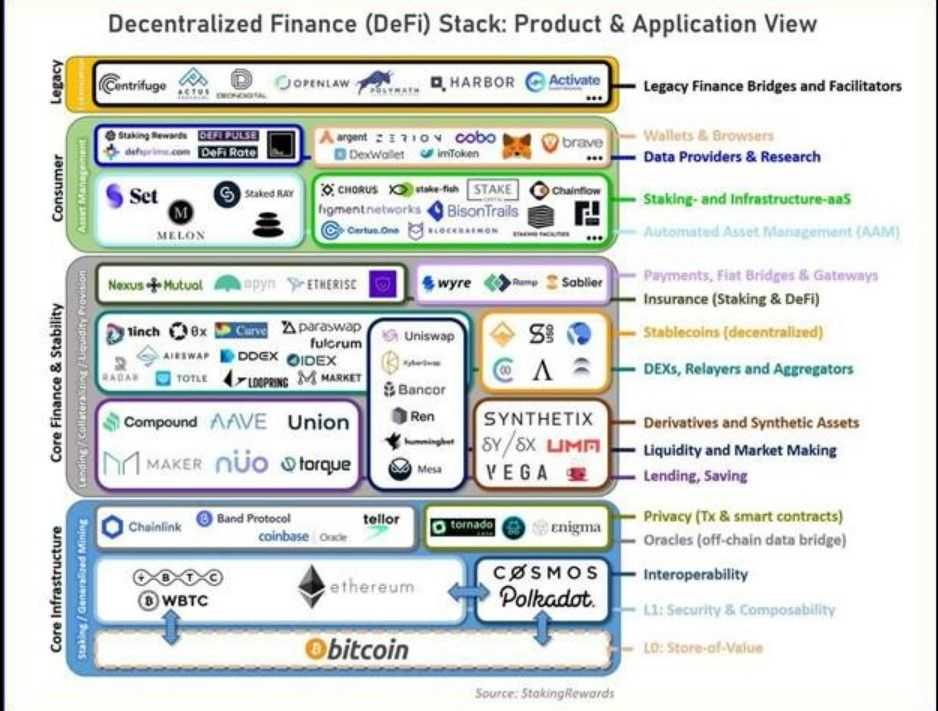
The Evolution of Web3 and Specialized Chains
As the blockchain landscape has matured, the array of possible use cases has expanded dramatically. This diversification reflects a natural evolution, where the one-size-fits-all approach of early blockchain networks increasingly falls short of meeting the nuanced demands of varied applications. Users now find themselves seeking out blockchain platforms that align more closely with their specific needs, often finding that Ethereum, despite its broad capabilities, does not satisfy every criterion for every use case. This trend has given rise to specialized blockchain networks, each honing in on particular attributes to serve distinct niches effectively.
- Scalability: As blockchain adoption grows, the need for networks that can handle large volumes of transactions quickly and affordably has become paramount. Scalable blockchains offer high transaction speeds and low fees, ensuring that as the user base expands, the network can accommodate the growing demand without compromising performance.
- Interoperability: In a fragmented blockchain ecosystem, the ability of different networks to communicate and share information is crucial. Interoperability ensures that siloed blockchains can connect, facilitating the seamless exchange of data and value across diverse platforms and enhancing the overall utility of the blockchain space.
- MEV (Miner Extractable Value): MEV refers to the profit miners can make by including, excluding, or re-ordering transactions within blocks. Specialized chains that address MEV aim to minimize its impact, ensuring fairer transaction ordering and reducing the potential for manipulation.
- On-chain Privacy: Privacy-centric blockchains focus on enhancing user anonymity and data protection. By integrating advanced cryptographic techniques, these networks ensure that transactions and interactions remain confidential, catering to users and organizations prioritizing privacy.
- Modularity: Modular blockchains offer a flexible approach where different components of the network (such as consensus, data availability, and execution) can be developed and improved independently. This adaptability allows for more targeted enhancements and upgrades, facilitating innovation and optimization across the network's architecture.
These specialized characteristics illustrate the blockchain ecosystem's shift towards a more segmented and sophisticated landscape, where diversity and specialization pave the way for more tailored and practical solutions. Here are notable layer-1 examples:
Solana
Solana is a prominent blockchain network that has gained attention for its unique approach to scalability and security, particularly through its Proof of History (PoH) consensus mechanism. This feature is central to its design, allowing Solana to process transactions at unprecedented speeds while maintaining low transaction costs.

Scalability
At the heart of Solana's scalability lies its Proof of History mechanism, which creates a historical record that proves an event has occurred at a specific moment in time (called timestamping). Timestamping is achieved without relying on the communication between nodes to determine transaction order. Solana can process transactions in parallel by cryptographically encoding the passage of time in the blockchain itself, significantly increasing its throughput. This architecture enables the network to handle tens of thousands of transactions per second, far surpassing traditional blockchains, all while keeping fees minimal.
MEV (Miner Extractable Value)
MEV refers to the profit miners can make by prioritizing, including, or excluding transactions within the blocks they produce. Solana's architecture, particularly its lack of a mempool due to the sequential processing enabled by PoH, reduces the opportunities for miners to exploit MEV. Without a mempool, transactions are processed in the order they are received, mitigating common issues like front-running or sandwich attacks, where miners could potentially manipulate the transaction order for profit.
Trade-off: Hardware Requirements
While Solana's design offers considerable benefits in terms of scalability and security, it comes with its set of trade-offs, notably the high-grade hardware required for running full nodes. This requirement can lead to potential centralization concerns, as the barrier to entry for validators is higher compared to networks with lower hardware requirements. This aspect could limit the number of nodes that can afford to participate in the network, potentially centralizing control to a smaller group of participants with the necessary resources.
If you’re curious about the intricacies of Solana, Coin Bureau’s Solana Review has got you covered!
For anyone looking to pick up some Solana, we recommend Bybit, OKX, and SwissBorg. UK and US readers can try Kraken and eToro US.
Sui
Sui is a novel blockchain network designed to enhance scalability and efficiency, leveraging its unique parallel execution model and the Move programming language. This combination allows Sui to process transactions quickly and cost-effectively, addressing some of the scalability challenges traditional blockchains face.
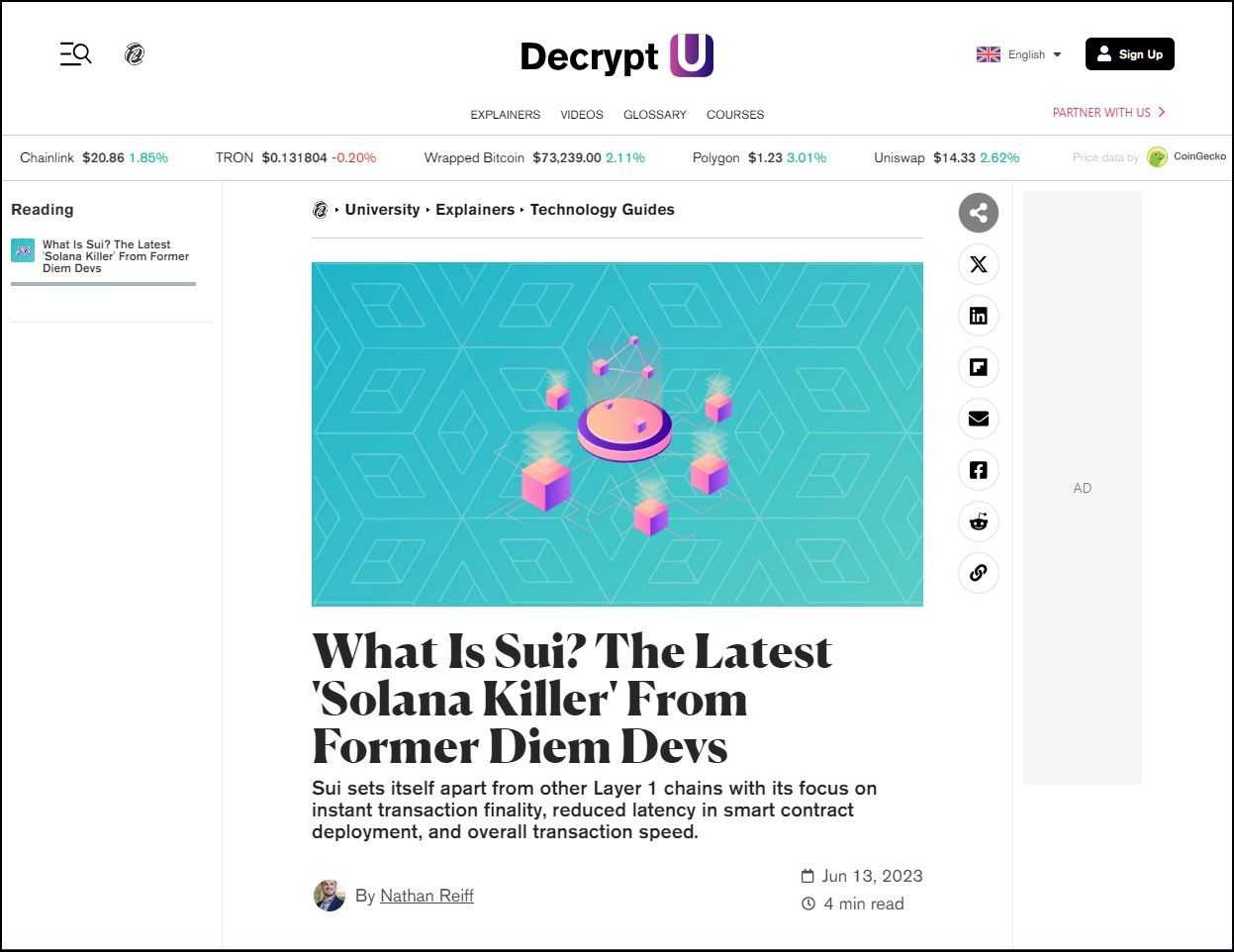
Scalability
Sui's parallel execution capability is a core feature that distinguishes it from other blockchains. Unlike traditional blockchains that process transactions sequentially, Sui can process multiple transactions simultaneously, significantly increasing its throughput. This ability to handle numerous transactions in parallel contributes to Sui's high transaction speeds and low fees, making it an attractive platform for a wide range of applications.
Trade-offs
There are trade-offs to consider with Sui's innovative approach. While offering several advantages regarding throughput and fees, the Move programming language represents a learning curve for developers accustomed to more common blockchain languages like Solidity, which offers wider opportunities to developers owing to its mainstream adoption.
Similar to Solana, Sui's network demands expensive hardware from its nodes, which could lead to potential centralization. Only those with access to high-grade hardware can afford to run full nodes, possibly concentrating network control among a limited number of participants.
Moreover, as a relatively new entrant in the blockchain space, Sui still needs to be battle-tested against the full array of market forces, raising questions about its resilience and stability under various conditions.
Coin Bureau’s Sui review will tell you everything you need to know about the new entrant in the Layer 1 space.
Great exchanges for picking up Sui are Bybit and OKX or Kraken for users based in the US and UK.
Near Protocol
Near Protocol is a cutting-edge platform designed to address earlier blockchain systems' scalability and usability challenges. A standout feature of Near is its Nightshade sharding protocol, which plays a pivotal role in its architecture, enhancing its efficiency and scalability.
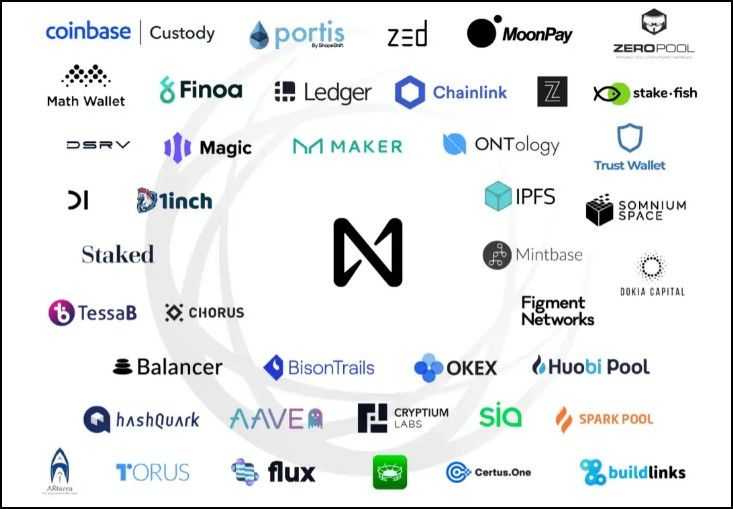
Scalability through Sharding
Nightshade, Near's unique sharding approach allows the network to divide its computational and storage workload across multiple parallel chains, significantly boosting its capacity to process transactions. Splitting the network into several shards enables Near to scale dynamically with demand, offering high transaction throughput while maintaining low fees. By processing transactions in parallel across different shards, Near can accommodate a growing user base and application ecosystem without the bottlenecks that affect non-sharded blockchains.
Trade-offs
Despite these advancements, Near faces some trade-offs. The Near Virtual Machine (NVM) is written in Rust, contrasting with Ethereum's EVM, which primarily uses Solidity. This discrepancy introduces a learning curve for developers who are familiar with Solidity and might consider migrating to Near, potentially slowing down the pace of adoption.
Furthermore, the network's decentralization level is a point of consideration. Near has around 210 nodes with $3.9 billion staked, which is modest compared to Ethereum's more extensive network of over 7,000 nodes and $163.5 billion staked (per NEAR and ETH price levels in March 2024). This difference highlights a disparity in network security and decentralization. Ethereum has a broader distribution of nodes and staked value, which can influence developers' and users' trust in the platform's resilience and long-term viability.
Coin Bureau’s Near review was a good refresher for me while working on this piece; it might also help you!
Near can be found on popular exchanges Bybit and OKX or Kraken for users based in the US and UK.
Avalanche
Avalanche utilizes a unique consensus mechanism that employs a sub-sampled voting system, allowing the network to reach consensus rapidly and efficiently. This process enhances the throughput of the network, as it enables quick validation of transactions. The speed at which consensus is achieved in Avalanche significantly contributes to its ability to scale, accommodating a high number of transactions per second.
Subnet System
The subnet system in Avalanche allows for the creation of bespoke subnetworks within the larger Avalanche ecosystem. This feature provides several advantages:
- Scalability: By segmenting the network into subnets, Avalanche can process transactions in parallel across different subnetworks, substantially increasing the network's overall capacity.
- Modular Security: Subnets can implement their own consensus protocols tailored to their specific needs. This flexibility ensures that each subnet can optimize its block construction rules but has to fend for its own security without relying on the AVAX consensus layer.
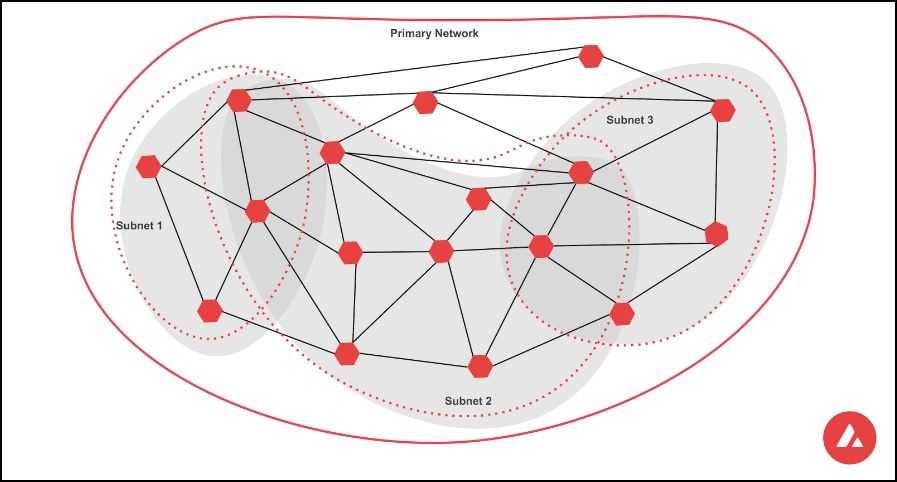
Development on Avalanche
Developers have two primary options when building on Avalanche:
- C-chain: By deploying applications on the Avalanche C-chain, developers can leverage the security and infrastructure of the Avalanche network while adhering to the mainnet's execution rules. This design is similar to layer-2 solutions in Ethereum, where the chain subnets inherit the security of the main network.
- Subnetwork: Creating a subnetwork allows for a more customized approach, where the chain can implement its own consensus protocol and deploy its own gas token. However, this comes with the trade-off of being responsible for its security and paying Avalanche validators in AVAX for their services.
Trade-offs
While Avalanche offers considerable scalability and customization benefits, there are trade-offs:
- The requirement for subnetworks to ensure their security and compensate validators could introduce additional complexity and costs for developers.
- The choice between using the C-chain or creating a subnetwork involves a balance between ease of integration and autonomy, with each option presenting its own set of constraints and advantages.
In summary, Avalanche's innovative approach to consensus and its subnet system provides a flexible and scalable environment for blockchain development. However, they come with security, cost, and technical complexity considerations.
At Coin Bureau, we review all promising projects in the industry, and Avalanche is no exception.
As a popular project, AVAX is available on Bybit, SwissBorg and OKX or Kraken for users based in the US and UK.
Cosmos Network
The Cosmos network, distinguished by its Tendermint core and Inter-Blockchain Communication (IBC) protocol, revolutionizes the development and interoperability of new Layer 1 chains. This ecosystem, often heralded as the "Internet of Blockchains," fosters an environment where various blockchains can communicate and operate seamlessly with one another.
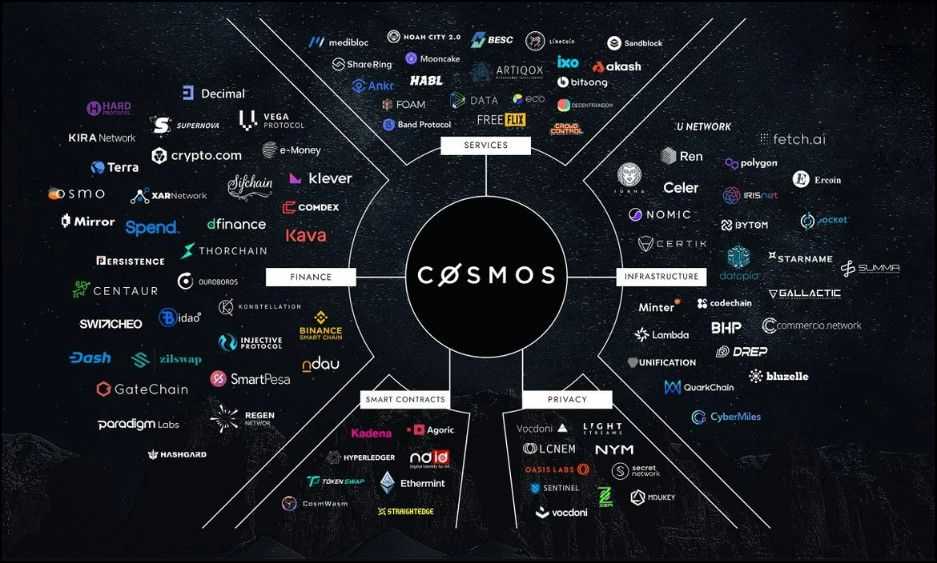
Interoperability
At the heart of Cosmos' interoperability feature is the Cosmos IBC, a trust-minimized protocol that facilitates the transfer of assets and data across independent blockchains. This capability allows for a more interconnected and efficient network where different blockchains can leverage each other's strengths and functionalities.
Developer-Friendly
The Cosmos SDK, a framework for building blockchain applications, simplifies creating new chains. It provides developers with the tools and modular components needed to develop bespoke blockchains without starting from scratch, enhancing innovation and reducing development time and cost.
Interchain Security
Cosmos introduces a novel concept of interchain security, where new chains can opt to use the security of the Cosmos Hub after receiving clearance for governnce, benefiting from its established validator set and the ATOM token's market cap. This model allows emerging chains to focus on development and user engagement rather than the complex task of securing a decentralized network.
Trade-offs
- A significant trade-off is that chains not utilizing Cosmos' interchain security must establish their own security mechanisms, which can be a considerable challenge. They need to attract a reliable validator set and ensure their native token has enough value to deter attacks. This process can be resource-intensive and detract from the project's other aspects.
- By leveraging interchain security, chains gain robust security from the get-go. Still, they must align with the Cosmos Hub's incentives, adding a layer of complexity to their economic and governance models. This trade-off emphasizes the balance between autonomy and security within the Cosmos ecosystem.
Learn more about the internet of blockchains in the Comsos review!
Cosmos has wide exchange support and can be found on Bybit, Binance and OKX or Kraken and eToro US for users based in the US and UK.
Polkadot
Polkadot is also known as the “layer 0” blockchain. It is not designed for smart contract applications. Rather, it provides shared security and interoperability to multiple blockchains running in parallel. These chains are called parachains, which inherit the security of the Polkadot mainnet (relay chain).
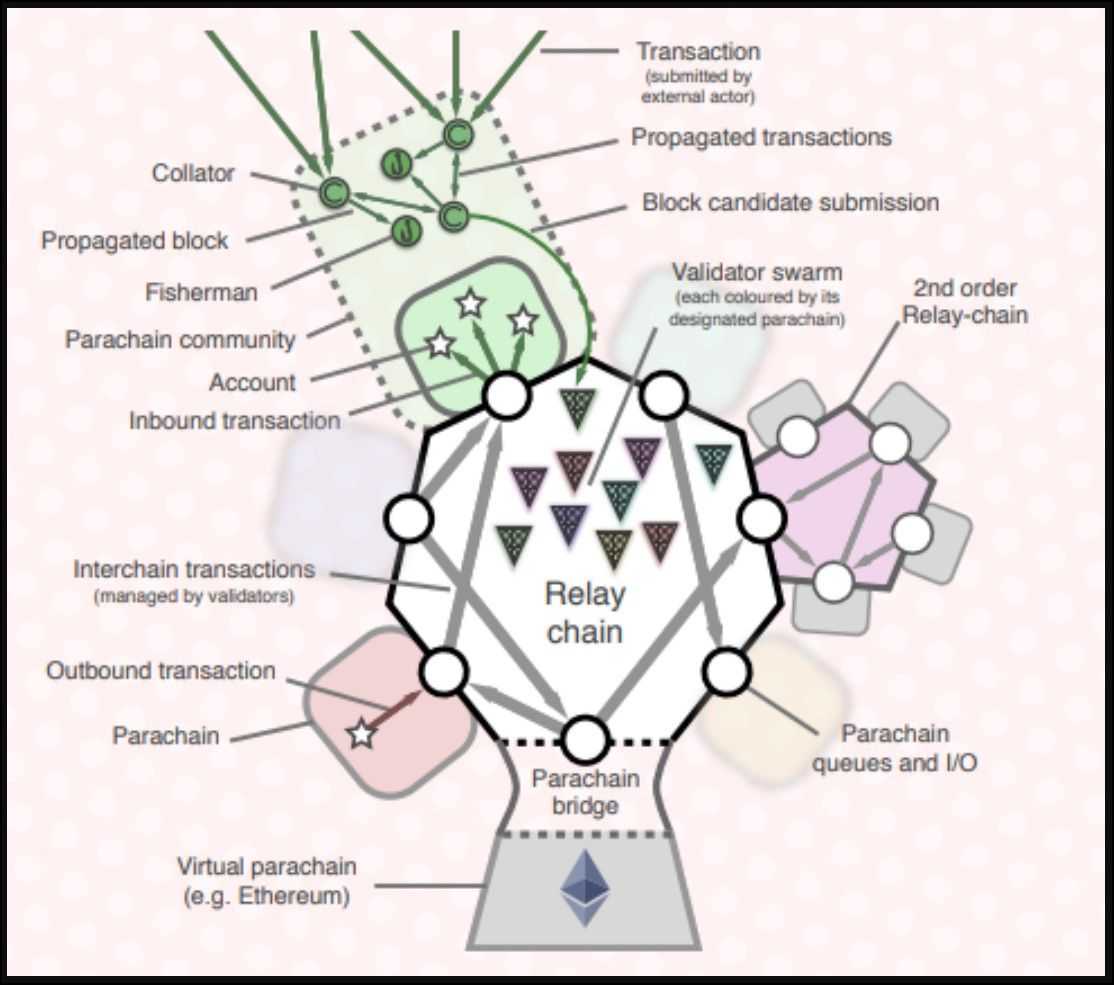
Scalability
Parachains can achieve high scalability by processing several and offloading the burden of consensus and finality to the relay chain. The relay chain nodes are collectively divided into 50 slots called cores. These cores run the parachain as full nodes where each parachain can subscribe to the processing power of cores based on its requirements, allowing it to achieve customizable scalability.
Security
The relay chain lends its security to the parachain by assuming additional slashing conditions from the parachains. The relay chain effectively concentrates the security of the entire ecosystem in a shared relay chain.
Interoperability
The relay chain operates as the settlement layer between the parachains, allowing them to interoperate with one another via the relay chain.
Validator Network
Polkadot deploys its relay chain validator network to run the parachains, which means that these chains do not have the burden of establishing their own validators, a significant barrier for emerging chains.
Trade-offs
- Limited coretime: Coretime describes the total bandwidth available in the Polkadot network to host parachains. Coretime is a dynamic and finite resource to which each parachain subscribes. There may be instances when the coretime becomes too expensive or unavailable during peak demand.
- Validator network: Polkadot network operates on a significantly smaller validator network than Ethereum, a trade-off it had to assume to achieve its throughput levels.
Polkadot 2.0 is here with mind-blowing updates! Check out the Polkadot 2.0 review.
Traders can find wide DOT support on exchanges like Bybit, Binance and OKX or Kraken for US and UK users.
Privacy of Secret Network and Silent Protocol
The Secret Network and the Silent Protocol are privacy-focused solutions that have the capability of hiding aspects of on-chain interactions.
Secret Network runs on a trustless component and a trusted component. The trustless component is Tendermint, which defines its core operations such as networking and consensus. The trusted component comprises enclaves, which are a trusted execution environment for the private processing of smart contracts. Enclaves work by executing smart contracts and sending the encrypted data to Tendermint for consensus.
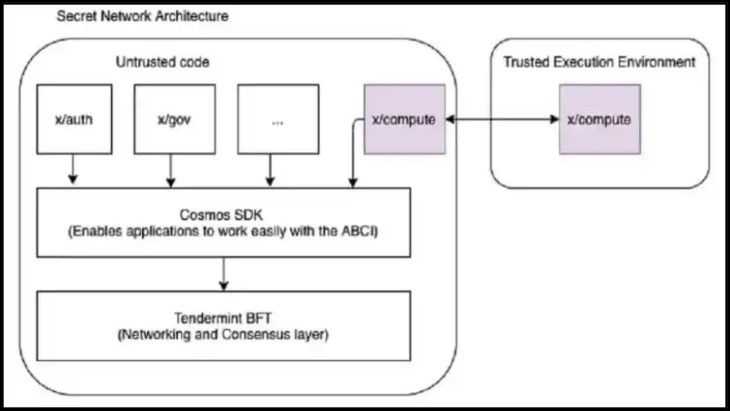
Silent Protocol is a privacy enhancement protocol that offers functional privacy solutions for layer-1 networks that do not have such measures built in, like the Ethereum network. Silent Protocol positions itself on the client side of decentralized applications. Clients (endpoints) are the user interface allowing users to interact with different smart contracts that make up Dapps. Clients are not typically part of the blockchain framework. They are usually domains managed by centralized services like AWS and can pose a privacy threat if not built securely.
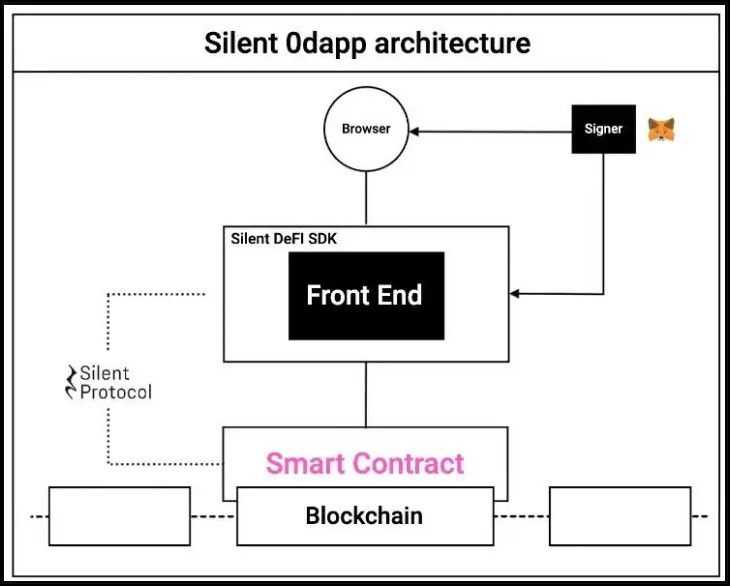
Privacy Trade-offs:
- Trust in Enclaves: While the trusted execution environments (enclaves) provide a robust privacy layer, they introduce a trust component in an otherwise trustless system. Users must trust the integrity and security of these enclaves, as any vulnerability could compromise the privacy and security of the network.
- Scope of Privacy: Silent Protocol focuses on client-side privacy, addressing a crucial but limited aspect of the blockchain privacy challenge. While it enhances user privacy at the client level, it does not provide privacy solutions for on-chain data or smart contract execution.
- Dependency on External Infrastructure: Since Silent Protocol operates at the client level, its effectiveness can be influenced by the security and privacy practices of the underlying infrastructure, such as web hosting services. This dependency could introduce vulnerabilities outside the blockchain itself.
Dig deeper and check out the Secret network review on Coin Bureau.
Idea 1: Closing Thoughts
Ethereum's simplicity is a double-edged sword. On one hand, this very characteristic has underpinned its success, making it a versatile foundation for many applications. On the other hand, as the blockchain domain expands and matures, there's an increasing demand for platforms that offer specialized functionalities. This diversification doesn't necessarily diminish Ethereum's value but highlights its role as a catalyst in the broader ecosystem's growth and evolution.
While Ethereum remains a bedrock for innovation, it still maintains the title of the most secure and decentralized smart contract network by many miles. The emergence of specialized chains signifies a healthy, evolving landscape where different platforms can coexist, each addressing unique needs and contributing to the blockchain technology tapestry.
Idea 2: Modularity Makes Comparing Blockchains Difficult
You might have noticed that in the above analysis, I deliberately excluded Ethereum's layer-2 solutions from our comparison to maintain fairness, as they aren't directly part of the Ethereum protocol. However, this raises an interesting question: is excluding these components truly beneficial or meaningful in our analysis?
As we delve into the concept of blockchain modularity, it's crucial to acknowledge Ethereum's strategic shift towards a rollup-centric roadmap. This evolution opens the door to abstracting Ethereum into its four underlying layers and leveraging them to achieve customizable scalability.
The Core Functions of Ethereum
Understanding the modular structure of Ethereum requires a breakdown of its four core functions:
- Execution Layer: This layer is responsible for aggregating transactions, performing necessary checks, executing them, and constructing the block. It's where the computation happens, and DeFi applications reside.
- Data Availability Layer: It holds transaction data during consensus, provides liveness guarantees, and ensures invalid transactions are rejected. The cost of data availability varies based on its nature:
- Data stored as call data is actively processed by base layer validators, incurring higher gas costs.
- Data stored as metadata occupies space but isn't actively processed, resulting in lower gas costs.
- Settlement Layer: This layer is crucial for security checks in case of fraud or validity proofs and acts as the liquidity layer in some configurations to facilitate trust-minimized bridges.
- Consensus Layer: This layer constitutes a consensus process that has validators agree on the transaction order, offering protection against chain reorganization attacks and similar threats.
Exploring Rollup Configurations
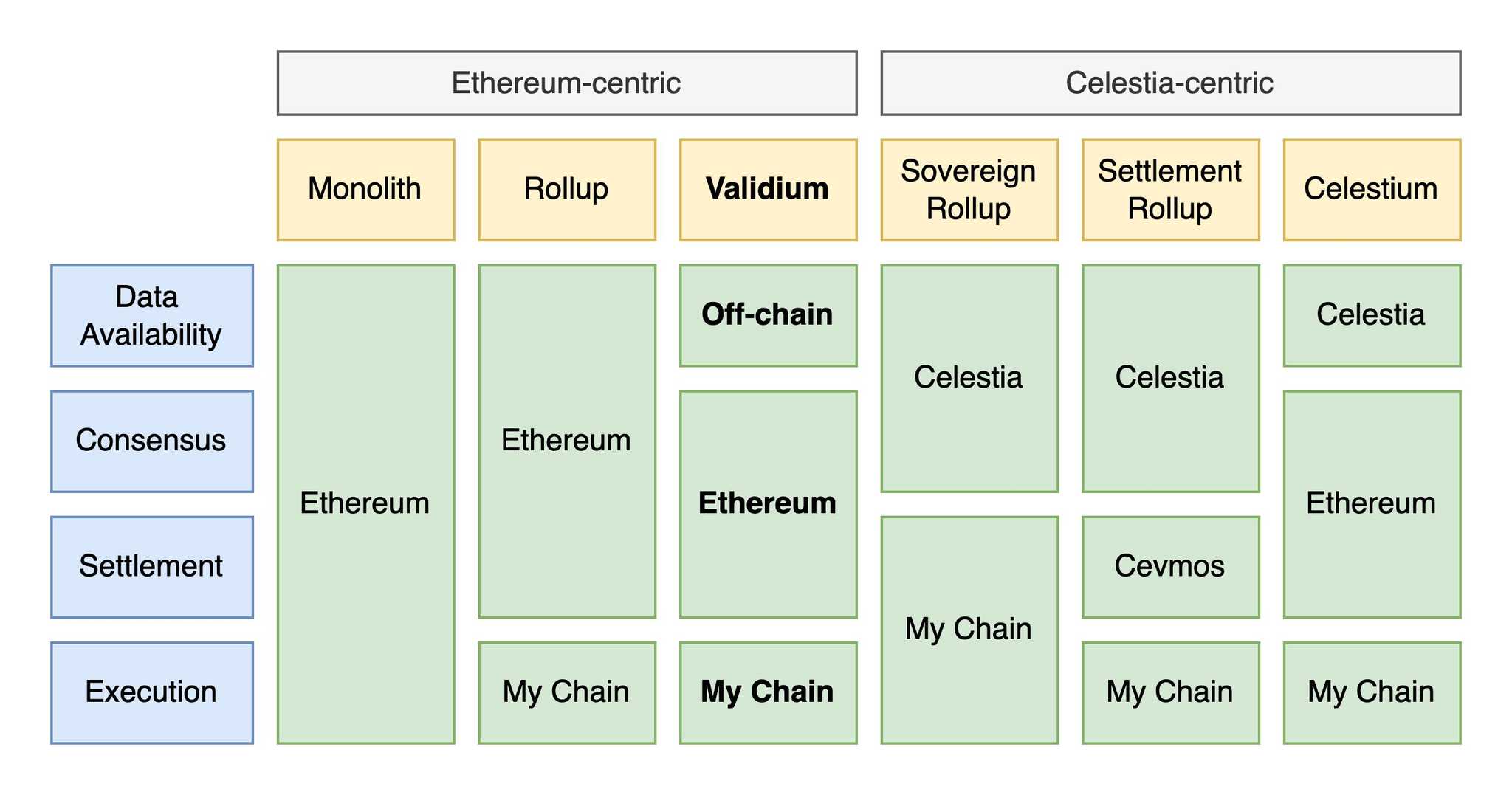
Think of the above blockchain layers as Legos that lend several benefits in different configurations. Here are some mainstream, niche, and novel blockchain configurations that capture the ethos of modularity:
Smart Contract Rollups
These rollups maintain a separate execution layer and rely on Ethereum for other operations. Relying on Ethereum for data availability ensures liveness, and settlement ensures transaction validity, while its consensus deters reorganization, lending full security to Ethereum.
Examples: Arbitrum and Optimism.
Sovereign Rollups on Celestia
Celestia is a general-purpose Data Availability and Consensus, similar to Ethereum, except that it does not comprise an Execution layer (like EVM). Therefore, Celestia does not process smart contracts or perform validity checks but specializes in DA and Consensus. Celestia pioneers Sovereign Rollups:
- These rollup designs have proprietary Execution and Settlement layers.
- These are rollups that leverage Celestia for DA and Consensus.
Taking care of its own settlement allows such rollups to set arbitrary transaction rules and execution environments, allowing a Layer-1-like autonomy protected by Celestia’s liveness and reorg guarantees.
Validium Rollups
A Validium design handles execution and DA on the layer-2, while relying on Ethereum for settlement and consensus. Validium rollups ensure their own liveness, but leverage Ethereum to validate its transactions and consensus. Managing DA outside Ethereum allows Validium to achieve very high throughputs.
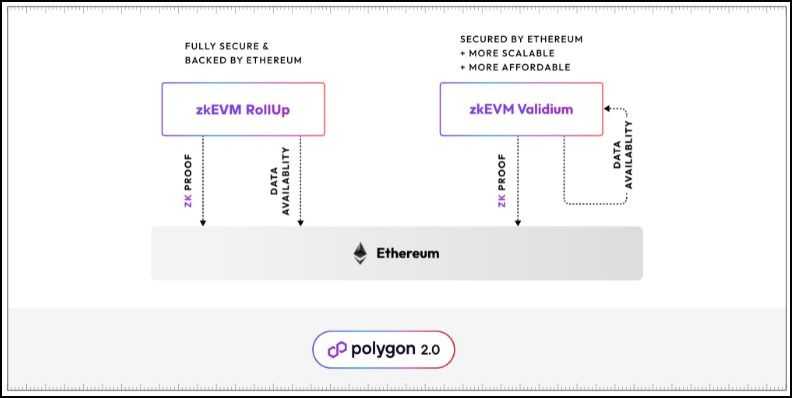
Polygon zkEVM Validium, the successor of the Polygon PoS chain, adopts the validium design. Polygon’s DA layer is secured using the POL token consensus protocol. (Read the Polygon 2.0 Review to learn more).
Implications of Modularity
There are projects working on even more intricate designs that use the best of both Ethereum and Celestia. The point I’m making is that the increasing interconnection and interdependence of various blockchain layers underscores the complexity and sophistication of the Web3 space. If Ethereum’s abstracted layers are accessible in isolation, enabling unique benefits in several scenarios, comparing blockchains as standalone networks becomes increasingly impractical as the ecosystem evolves to prioritize application-specific configurations and collaborative frameworks.
Conclusion: Embracing the Complexity of Web3
The modular nature of blockchains in 2024 is a testament to the sector's maturity and innovation. As Ethereum and other platforms continue to evolve, the traditional metrics for blockchain comparison must adapt to reflect the intricate interplay of various layers and components. Understanding and appreciating this complexity will enable us to make more informed decisions about utilizing blockchain technology, fostering a more robust, efficient, and interconnected Web3 ecosystem where specialization and collaboration drive progress and value creation.
Ethereum Killers Narrative: Closing Thoughts
In conclusion, our journey through the evolving landscape of blockchain technology highlights several key insights that reshape our understanding of Ethereum and its relationship with other Layer 1 blockchains.
Firstly, Ethereum's success is intricately linked to its first-mover advantage and simplicity—a foundational design choice that has fostered a broad spectrum of applications and innovations. This simplicity, however, isn't merely a byproduct of limited capabilities but a strategic choice that has allowed Ethereum to become the backbone of decentralized applications. The notion of replicating another "simple" chain akin to Ethereum seems economically redundant when Ethereum itself continues to serve this foundational role effectively.
Secondly, the narrative surrounding "Ethereum killers" requires reevaluation. These blockchains aren't necessarily in a winner-takes-all battle with Ethereum but are carving out their niches by emphasizing particular features or efficiencies. While there might be some migration from Ethereum to these specialized networks—partly due to the lack of alternatives in the past—it's becoming increasingly clear that the blockchain ecosystem is vast enough to support multiple thriving networks. Ethereum and its so-called competitors can coexist, each catering to distinct needs and preferences within the broader Web3 landscape.
Lastly, the concept of modularity redefines the Ethereum ecosystem's role and its interplay with the broader blockchain landscape. By segmenting its functions, Ethereum not only enhances its own scalability and efficiency but also contributes to a more interconnected and versatile Web3 environment. This modular framework fosters a new paradigm where Ethereum's infrastructure supports a multitude of specialized networks, each optimizing different aspects of blockchain technology. Thus, Ethereum's journey toward modularity is about circumventing its limitations and amplifying its strengths by embracing a more collaborative and multifaceted role in the blockchain ecosystem.
In this new light, Ethereum and emerging blockchain networks are not mere competitors but integral components of a cohesive, multi-layered Web3 universe, each augmenting the other's capabilities and co-creating a more robust and adaptable digital infrastructure.
Frequently Asked Questions
Ethereum killers are not necessarily dominating over Ethereum; they are specializing in areas where Ethereum has limitations. While these networks offer innovative solutions, Ethereum remains a foundational blockchain due to its simplicity, broad adoption, and role as a platform for decentralized applications. The landscape is evolving towards coexistence rather than domination, with each blockchain serving unique use cases within the Web3 ecosystem.
Examples of Ethereum killers include Solana, known for its high transaction speed; Polkadot, which emphasizes interoperability; Cosmos, focusing on a network of interconnected blockchains; and Avalanche, recognized for its consensus mechanism enhancing scalability and transaction finality. These platforms are termed "killers" due to their aim to address specific challenges that Ethereum faces.
Modularity in blockchain technology signifies a shift toward more flexible and adaptable ecosystems. It allows for the separation of core blockchain functions into distinct layers or components, enhancing scalability, efficiency, and innovation. For Ethereum, modularity facilitates addressing its inherent limitations while enabling it to integrate with and support a variety of specialized networks and layer 2 solutions.
The future of Ethereum appears to be geared towards becoming more modular and interconnected, focusing on its strengths as a settlement layer while embracing layer 2 solutions and other blockchain integrations for enhanced scalability and functionality. This evolution will likely solidify Ethereum's position as a fundamental infrastructure within the Web3 ecosystem, enabling diverse applications and fostering collaboration across different blockchain networks.
Disclaimer: These are the writer’s opinions and should not be considered investment advice. Readers should do their own research.


